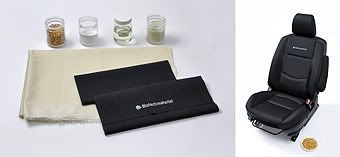The bioeconomy at work: Mazda develops 100% PLA based biofabric for vehicle interiors
The world’s first biofabric made with completely plant-derived fibers, suitable for use in vehicle interiors, has been developed by Mazda Motor Corporation in collaboration with Teijin Limited and Teijin Fibers Limited. The innovation shows again that the automotive industry is playing a vanguard role in the development of biobased plastics and materials that replace petroleum based products (overview of other examples). 
This newly developed biofabric does not contain any oil-based materials, yet it possesses the quality and durability required for use in vehicle seat covers. Resistant to abrasion and damage from sunlight, in addition to being flame retardant, the new biofabric meets the highest quality standards. Based on this biotechnology, Mazda will strengthen its future research and development on non-food-based materials in consideration of the impact such technologies have on food supplies.
Mazda plans to use the biofabric for the seat covers and door trim in the all-new Premacy Hydrogen RE Hybrid that will be exhibited in October at the Tokyo Motor Show 2007. The all-new Premacy Hydrogen RE Hybrid will also feature a bioplastic, which Mazda developed in 2006, in the vehicle’s instrument panel and other interior fittings.
The biofabric is made of 100 percent polylactic acid - a plastic created by combining large numbers of lactic acid molecules that are made from fermented carbohydrates such as plant sugars:
 energy :: sustainability :: bioenergy :: biofuels :: biomass :: polylactic acid :: bioplastic :: biofabric :: bioeconomy ::
energy :: sustainability :: bioenergy :: biofuels :: biomass :: polylactic acid :: bioplastic :: biofabric :: bioeconomy ::
Mazda developed this new biofabric in collaboration with Teijin Limited and Teijin Fibers Limited, companies with R&D and manufacturing sites in the region near Mazda’s headquarters in Hiroshima.
Other crucial qualities necessary for the highest performing fabrics, such as fire retardant properties, were achieved through Mazda’s accumulated experience in surface technologies built up through years of cooperation with several local companies.
All of Mazda’s biomaterials fall under the “Mazda Biotechmaterial” brand name. Mazda is dedicated to continuing its research and development efforts for these environmentally friendly technologies which will help to realize a sustainable society in the future.

Mazda plans to use the biofabric for the seat covers and door trim in the all-new Premacy Hydrogen RE Hybrid that will be exhibited in October at the Tokyo Motor Show 2007. The all-new Premacy Hydrogen RE Hybrid will also feature a bioplastic, which Mazda developed in 2006, in the vehicle’s instrument panel and other interior fittings.
We are convinced that our new technology, which enables the manufacture of this material without any oil-based resources, will become a cornerstone for future biotechnologies aimed at reducing the burden on the environment. Mazda, working together with our locally-based partners, will continue its research and development programs aimed at achieving a future car society that is eco-friendly. - Seita Kanai, Mazda’s director and senior executive officer in charge of R&DThis newly developed biofabric has harnessed the latest technologies to control the entire molecular architecture of raw resins to improve fiber strength until the fabric attained sufficient resistance to abrasion and light damage for practical use in vehicle seat covers.
The biofabric is made of 100 percent polylactic acid - a plastic created by combining large numbers of lactic acid molecules that are made from fermented carbohydrates such as plant sugars:
 energy :: sustainability :: bioenergy :: biofuels :: biomass :: polylactic acid :: bioplastic :: biofabric :: bioeconomy ::
energy :: sustainability :: bioenergy :: biofuels :: biomass :: polylactic acid :: bioplastic :: biofabric :: bioeconomy :: Mazda developed this new biofabric in collaboration with Teijin Limited and Teijin Fibers Limited, companies with R&D and manufacturing sites in the region near Mazda’s headquarters in Hiroshima.
Other crucial qualities necessary for the highest performing fabrics, such as fire retardant properties, were achieved through Mazda’s accumulated experience in surface technologies built up through years of cooperation with several local companies.
All of Mazda’s biomaterials fall under the “Mazda Biotechmaterial” brand name. Mazda is dedicated to continuing its research and development efforts for these environmentally friendly technologies which will help to realize a sustainable society in the future.
 --------------
--------------
 OPEC decided today to increase the volume of crude supplied to the market by Member Countries (excluding Angola and Iraq) by 500,000 b/d, effective 1 November 2007. The decision comes after oil reached near record-highs and after Saudi Aramco announced that last year's crude oil production declined by 1.7 percent, while exports declined by 3.1 percent.
OPEC decided today to increase the volume of crude supplied to the market by Member Countries (excluding Angola and Iraq) by 500,000 b/d, effective 1 November 2007. The decision comes after oil reached near record-highs and after Saudi Aramco announced that last year's crude oil production declined by 1.7 percent, while exports declined by 3.1 percent.








0 Comments:
Post a Comment
Links to this post:
Create a Link
<< Home